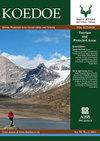Analysis of three decades of land cover changes in the Maputaland Coastal Plain, South Africa
IF 1.1
4区 环境科学与生态学
Q3 BIODIVERSITY CONSERVATION
引用次数: 3
Abstract
Changes in land use and land cover over time and space indicate socioeconomic change. Population growth and consequent demand for economic development have increased the conversion of natural vegetation. The KwaZulu-Natal Province has experienced an accumulated transformation of 45.6% of natural vegetation between 1994 and 2008 (Jewitt 2012:12). One area that has been affected by land cover transformation is the Maputaland Coastal Plain (MCP) located in the north-east of the KwaZulu-Natal Province of South Africa, which is rich in biodiversity and other natural resources (Orimoloye et al. 2019:3). The MCP has several wetlands, lakes and game reserves, which play an integral role in maintaining a healthy ecosystem. The largest freshwater lake in South Africa, Lake Sibayi, and the iSimangaliso Wetland Park, which is a renowned Ramsar and World Heritage site, are located within the MCP (Weitz & Demlie 2014:1). However, recent studies indicated that surface waters and wetland systems in the MCP are under severe threat because of plantations and water extraction (Everson et al. 2019:1; Orimoloye et al. 2019:9; Smithers et al. 2017:490). A large part of the Lake Sibayi catchment area is covered by plantations (Everson et al. 2019:34; Weitz & Demlie 2014:1). Mbazwana and Manzegwena, the two largest plantations, cover approximately 8500 and 15 000 ha, respectively, and were established in the 1960s by the KwaZulu Department of Forestry (SA Forestry 2012:1).南非马普塔兰海岸平原30年土地覆盖变化分析
土地利用和土地覆盖随时间和空间的变化反映了社会经济的变化。人口增长和随之而来的经济发展需求增加了自然植被的转换。夸祖鲁-纳塔尔省在1994年至2008年期间经历了45.6%自然植被的累计转变(Jewitt 2012:12)。受土地覆盖变化影响的一个地区是位于南非夸祖鲁-纳塔尔省东北部的马普塔兰沿海平原(MCP),该地区拥有丰富的生物多样性和其他自然资源(Orimoloye et al. 2019:3)。MCP有几个湿地、湖泊和野生动物保护区,在维持健康的生态系统方面发挥着不可或缺的作用。南非最大的淡水湖Sibayi湖和iSimangaliso湿地公园位于MCP内,该公园是著名的拉姆萨尔湿地和世界遗产(Weitz & Demlie 2014:1)。然而,最近的研究表明,由于人工林和取水,MCP的地表水和湿地系统受到严重威胁(Everson et al. 2019:1;Orimoloye等,2019:9;Smithers et al. 2017:490)。斯巴依湖集水区的很大一部分被种植园覆盖(Everson et al. 2019:34;Weitz & Demlie 2014:1)。Mbazwana和Manzegwena是两个最大的种植园,分别占地约8500公顷和15000公顷,由夸祖鲁林业部(SA Forestry 2012:1)于20世纪60年代建立。
本文章由计算机程序翻译,如有差异,请以英文原文为准。
求助全文
约1分钟内获得全文
求助全文
来源期刊

Koedoe
BIODIVERSITY CONSERVATION-
CiteScore
3.30
自引率
0.00%
发文量
10
审稿时长
20 weeks
期刊介绍:
Koedoe, with the subtitle ''African Protected Area Conservation and Science'', promotes and contributes to the scientific (biological) and environmental (ecological and biodiversity) conservation practices of Africa by defining the key disciplines that will ensure the existence of a wide variety of plant and animal species in their natural environments (biological diversity) in Africa.
 求助内容:
求助内容: 应助结果提醒方式:
应助结果提醒方式:


